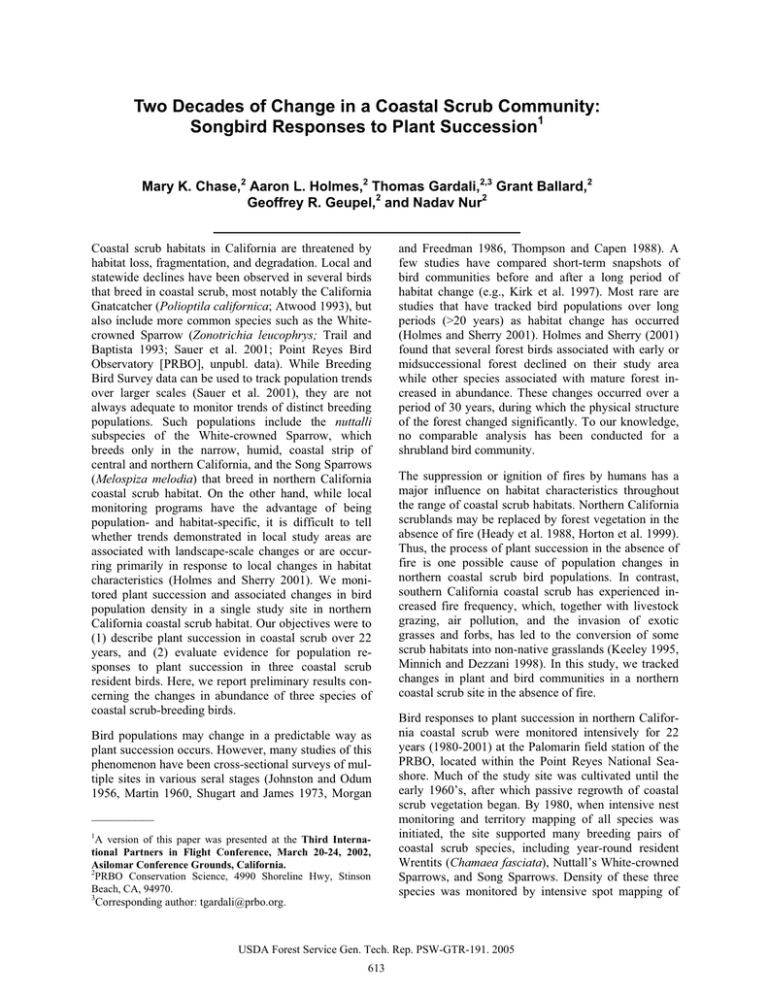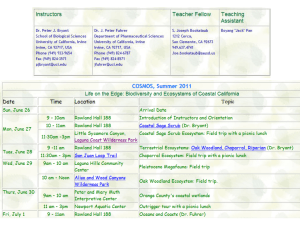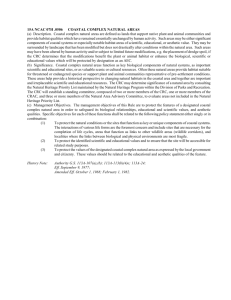Two Decades of Change in a Coastal Scrub Community:
advertisement

Two Decades of Change in a Coastal Scrub Community: Songbird Responses to Plant Succession1 Mary K. Chase,2 Aaron L. Holmes,2 Thomas Gardali,2,3 Grant Ballard,2 Geoffrey R. Geupel,2 and Nadav Nur2 ________________________________________ Coastal scrub habitats in California are threatened by habitat loss, fragmentation, and degradation. Local and statewide declines have been observed in several birds that breed in coastal scrub, most notably the California Gnatcatcher (Polioptila californica; Atwood 1993), but also include more common species such as the Whitecrowned Sparrow (Zonotrichia leucophrys; Trail and Baptista 1993; Sauer et al. 2001; Point Reyes Bird Observatory [PRBO], unpubl. data). While Breeding Bird Survey data can be used to track population trends over larger scales (Sauer et al. 2001), they are not always adequate to monitor trends of distinct breeding populations. Such populations include the nuttalli subspecies of the White-crowned Sparrow, which breeds only in the narrow, humid, coastal strip of central and northern California, and the Song Sparrows (Melospiza melodia) that breed in northern California coastal scrub habitat. On the other hand, while local monitoring programs have the advantage of being population- and habitat-specific, it is difficult to tell whether trends demonstrated in local study areas are associated with landscape-scale changes or are occurring primarily in response to local changes in habitat characteristics (Holmes and Sherry 2001). We monitored plant succession and associated changes in bird population density in a single study site in northern California coastal scrub habitat. Our objectives were to (1) describe plant succession in coastal scrub over 22 years, and (2) evaluate evidence for population responses to plant succession in three coastal scrub resident birds. Here, we report preliminary results concerning the changes in abundance of three species of coastal scrub-breeding birds. Bird populations may change in a predictable way as plant succession occurs. However, many studies of this phenomenon have been cross-sectional surveys of multiple sites in various seral stages (Johnston and Odum 1956, Martin 1960, Shugart and James 1973, Morgan __________ 1 A version of this paper was presented at the Third International Partners in Flight Conference, March 20-24, 2002, Asilomar Conference Grounds, California. 2 PRBO Conservation Science, 4990 Shoreline Hwy, Stinson Beach, CA, 94970. 3 Corresponding author: tgardali@prbo.org. and Freedman 1986, Thompson and Capen 1988). A few studies have compared short-term snapshots of bird communities before and after a long period of habitat change (e.g., Kirk et al. 1997). Most rare are studies that have tracked bird populations over long periods (>20 years) as habitat change has occurred (Holmes and Sherry 2001). Holmes and Sherry (2001) found that several forest birds associated with early or midsuccessional forest declined on their study area while other species associated with mature forest increased in abundance. These changes occurred over a period of 30 years, during which the physical structure of the forest changed significantly. To our knowledge, no comparable analysis has been conducted for a shrubland bird community. The suppression or ignition of fires by humans has a major influence on habitat characteristics throughout the range of coastal scrub habitats. Northern California scrublands may be replaced by forest vegetation in the absence of fire (Heady et al. 1988, Horton et al. 1999). Thus, the process of plant succession in the absence of fire is one possible cause of population changes in northern coastal scrub bird populations. In contrast, southern California coastal scrub has experienced increased fire frequency, which, together with livestock grazing, air pollution, and the invasion of exotic grasses and forbs, has led to the conversion of some scrub habitats into non-native grasslands (Keeley 1995, Minnich and Dezzani 1998). In this study, we tracked changes in plant and bird communities in a northern coastal scrub site in the absence of fire. Bird responses to plant succession in northern California coastal scrub were monitored intensively for 22 years (1980-2001) at the Palomarin field station of the PRBO, located within the Point Reyes National Seashore. Much of the study site was cultivated until the early 1960’s, after which passive regrowth of coastal scrub vegetation began. By 1980, when intensive nest monitoring and territory mapping of all species was initiated, the site supported many breeding pairs of coastal scrub species, including year-round resident Wrentits (Chamaea fasciata), Nuttall’s White-crowned Sparrows, and Song Sparrows. Density of these three species was monitored by intensive spot mapping of USDA Forest Service Gen. Tech. Rep. PSW-GTR-191. 2005 613 Succession in Coastal Scrub – Chase et al. A 0.20 25 A 20 15 10 5 0 1980 1985 1990 1995 2000 60 B 50 40 30 20 10 0.15 0 1980 0.10 1985 1990 1995 2000 50 0.05 Song Sparrow females % Cover of Douglas-fir 0.25 White-crowned Sparrow females Vegetation on the study area changed dramatically between 1980 and 2001. Most notably, Douglas-fir (Pseudotsuga menziesii) cover and height increased significantly on the study plot (fig. 1). Results of territory mapping during this same period showed a large and significant decline in the breeding density of White-crowned Sparrows (fig. 2A). The density of Wrentits increased dramatically over most of the study period, but declined slightly in the last three years of the study (fig. 2B). Song Sparrow density showed only a weak trend over time (fig. 2C). 2001). During the same period, declines were observed in both White-crowned Sparrows (-2.0 percent annual trend, P = 0.01, N = 56 routes) and Wrentits (-1.6 percent annual trend, P = 0.01, N = 40 routes), while Song Sparrows showed a weak declining trend (-0.7 percent annual trend, P = 0.11, N = 72). Thus, local trends appear to correspond to larger-scale trends for White-crowned Sparrows and Song Sparrows, but not for Wrentits. Wrentit females color-banded individuals (March-July; for more details on methods, see Silkey et al. 1999). The number of females breeding on the study area in each year was used as a measure of density. Plant succession was monitored at 40-m line-intercept transects placed at 40 locations in 1981/1982 and 2000 (27 in formerly cultivated, disturbed habitat and 13 in undisturbed habitat). The cover and height of each shrub or tree along the transect was recorded. Plant characteristics were compared between the two sampling periods using twotailed t-tests. Linear regression was used to analyze trends in bird density. 0.00 1981-82 2000 Height of Douglas-fir (m) 3 B 2 C 40 30 20 10 0 1980 1985 1990 1995 2000 Year 1 0 1981-82 2000 Year of Sampling Figure 1— Mean and standard error of Douglas-fir cover (A) and height (B) at 40 transects in the Palomarin study area shortly after the beginning of the study and in 2000 (cover: t = -4.42, df = 78, P < 0.001; height: t = -6.90, df = 78, P < 0.001). These local trends can be compared with Breeding Bird Survey results for the physiographic area in which our site is located (southern Pacific rainforests; Sauer et al. Figure 2ņ Population trends of three resident coastal scrub birds in the Palomarin study area, 1980-2001. Whitecrowned Sparrows declined significantly (r2 = 0.71, F1,20 = 48.97, P < 0.001), Wrentits increased significantly (r2 = 0.54, F1,20 = 23.54, P < 0.001) and Song Sparrows showed a weak declining trend (r2 = 0.24, F1,20 = 6.42, P = 0.02). Note differences in scale on y-axes. In conclusion, Wrentit and White-crowned Sparrow density may have responded to plant succession, while Song Sparrow density did not appear to do so. Although our results are correlational, they are consistent with what is known about the habitat associations of our study species: USDA Forest Service Gen. Tech. Rep. PSW-GTR-191. 2005 614 Succession in Coastal Scrub – Chase et al. x Wrentits are associated with dense shrub cover (Geupel and Ballard 2002) and thus may have responded to the increase in cover by shrubby young Douglas-fir; Chilton, G., M. C. Baker, C. D. Barrentine, and M. A. Cunningham. 1995. White-crowned Sparrow (Zonotrichia leucophrys). In: Poole, A. and F. Gill, editors. The Birds of North America, No. 183. Philadelphia, PA: The Bird of North America, Inc. x White-crowned Sparrows are associated with more open scrub habitats, containing grass and some bare ground for foraging (Chilton et al. 1995); and Geupel, G. R., and G. Ballard. 2002. Wrentit (Chamaea fasciata). In: Poole, A. and F. Gill, editors. The Birds of North America, No. 654. Philadelphia, PA: The Birds of North America, Inc. x Song Sparrows are relative generalists, occurring in California in a variety of habitats that are typically moist, with low, dense cover or brushy, weedy edges (Small 1994). Heady, H. F., T. C. Foin, M. M. Hektner, D. W. Taylor, M. G. Barbour, and W. J. Barry. 1988. Coastal prairie and northern coastal scrub. In: Barbour, M. G. and J. Major, editors. Terrestrial vegetation of California. New York, NY: John Wiley & Sons; 733-760. In the future, we plan to evaluate population responses to succession in this site for the entire avian community and to model variation in bird population density in relation to changes in habitat characteristics and weather over time. Preliminary analyses suggest that changes in White-crowned Sparrow and Wrentit density paralleled vegetation change, while variation in Song Sparrow density was more closely related to weather (PRBO, unpubl. data). While plant succession in the absence of fire may have influenced our local populations, more study is needed to evaluate this process as a potential cause of larger-scale bird population trends in northern coastal scrub. However, given the dramatic invasion of trees into our study site, our results suggest that habitat reserves in northern coastal scrub may need active management to retain both early successional scrub habitat, for species such as White-crowned Sparrow, and more mature scrub, for species such as Wrentit. Holmes, R. T., and T. W. Sherry. 2001. Thirty-year bird population trends in an unfragmented temperate deciduous forest: importance of habitat change. Auk 118: 589-609. Acknowledgments Minnich, R. A., and R. J. Dezzani. 1998. Historical decline of coastal sage scrub in the Riverside-Perris Plain, California. Western Birds 29: 366-391. We are grateful to L. R. Mewaldt, C. J. Ralph and D. DeSante for their foresight in establishing the longterm research program at the Palomarin Field Station. This study would not have been possible without the dedicated fieldwork of many interns and staff biologists of the PRBO terrestrial research program. We are indebted to the staff of the Point Reyes National Seashore for their continued cooperation. We are grateful for financial support by the David and Lucile Packard Foundation for PRBO’s conservation science and adaptive conservation planning efforts in California. This is PRBO contribution number 1046. Horton, T., T. Bruns, and V. Parker. 1999. Ectomycorrhizal fungi associated with Arctostaphylos contribute to Pseudotsuga menziesii establishment. Canadian Journal of Botany 77: 93-102. Johnston, D. W., and E. P. Odum. 1956. Breeding bird populations in relation to plant succession on the Piedmont of Georgia. Ecology 37: 50-62. Keeley, J. E. 1995. Future of California floristics and systematics: Wildfire threats to the California flora. Madroño 42: 175-179. Kirk, D. A., A. W. Diamond, A. R. Smith, G. E. Holland, and P. Chytyk. 1997. Population changes in boreal forest birds in Saskatchewan and Manitoba. Wilson Bulletin 109: 1-27. Martin, N. D. 1960. An analysis of bird populations in relation to forest succession in Algonquin Provincial Park, Ontario. Ecology 41: 126-140. Morgan, K., and B. Freedman. 1986. Breeding bird communities in a hardwood forest succession in Nova Scotia. Canadian Field-Naturalist 100: 506-519. Sauer, J. R., J. E. Hines, and J. Fallon. 2001. The North American Breeding Bird Survey, Results and Analysis 1966 2000. Version 2001.2. Laurel, MD: Patuxent Wildlife Research Center, U.S. Geological Survey. http://www.mbrpwrc.usgs.gov/bbs Shugart, Jr., H. H., and D. James. 1973. Ecological succession of breeding bird populations in northwestern Arkansas. Auk 90: 62-77. Silkey, M., N. Nur, and G. R. Geupel. 1999. The use of mist-net capture rates to monitor annual variation in abundance: A validation study. Condor 101: 288-298. Literature Cited Atwood, J. L. 1993. California Gnatcatchers and coastal sage scrub: The biological basis for endangered species listing. In: J. E. Keeley, editor. Interface between ecology and land development in California. Los Angeles, CA: Southern California Academy of Sciences; 149-166. Small, A. 1994. California birds: Their status and distribution. Vista, CA: Ibis Publishing Company. USDA Forest Service Gen. Tech. Rep. PSW-GTR-191. 2005 615 Succession in Coastal Scrub – Chase et al. Thompson III, F. R. and D. E. Capen. 1988. Avian assemblages in seral stages of a Vermont forest. Journal of Wildlife Management 52: 771-777. Trail, P. W. and L. F. Baptista. 1993. The Impact of BrownHeaded Cowbird Parasitism on Populations of the Nuttall White-Crowned Sparrow. Conservation Biology 7: 309-315. USDA Forest Service Gen. Tech. Rep. PSW-GTR-191. 2005 616







